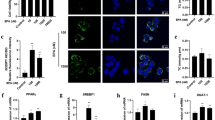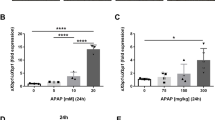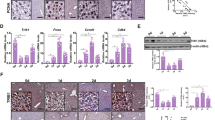Abstract
Aim:
The nuclear factor erythroid 2-related factor 2 (NRF2) acts through the antioxidant response element (ARE) to regulate the expression of many detoxifying and antioxidant genes responsible for cytoprotective processes. We previously reported that Schisandrol B (SolB) isolated from Schisandra sphenanthera produced a protective effect against acetaminophen (APAP)-induced liver injury. In this study we investigated whether the NRF2/ARE signaling pathway was involved in this hepato-protective effect.
Methods:
Male C57BL/6 mice were treated with SolB (200 mg·kg−1·d−1, ig) for 3 d before injection of APAP (400 mg/kg, ip). Serum and liver tissue samples were collected 6 h later. The mRNA and protein expression were measured using qRT-PCR and Western blot assay, respectively. The activation of NRF2 was examined in HepG2 cells using luciferase reporter gene assay.
Results:
SolB pretreatment significantly alleviated the hepatic injury (large patchy necrosis and hyperemia of the hepatic sinus), the increase of serum AST, ALT levels and hepatic MDA contents, and the decrease of liver and mitochondrial glutathione levels in APAP-treated mice. Furthermore, SolB pretreatment significantly increased nuclear accumulation of NRF2 and increased hepatic expression of NRF2 downstream proteins, including GCLC, GSR, NQO1, GSTs, MRP2, MRP3 and MRP4 in APAP-treated mice. Moreover, treatment with SolB (2.5–20 μmol/L) dose-dependently increased the activity of NRF2 reporter gene in HepG2 cells.
Conclusion:
SolB exhibits a remarkable protective effect against APAP-induced hepatotoxicity, partially via activation of the NRF2/ARE pathway and regulation of NRF2 target genes, which induce detoxification and increase antioxidant capacity.
Similar content being viewed by others
Log in or create a free account to read this content
Gain free access to this article, as well as selected content from this journal and more on nature.com
or
References
Dargan PI, Jones AL . Acetaminophen poisoning: an update for the intensivist. Crit Care 2002; 6: 108–10.
Ghosh J, Das J, Manna P, Sil PC . Arjunolic acid, a triterpenoid saponin, prevents acetaminophen (APAP)-induced liver and hepatocyte injury via the inhibition of APAP bioactivation and JNK-mediated mitochondrial protection. Free Radic Biol Med 2010; 48: 535–53.
McGill MR, Sharpe MR, Williams CD, Taha M, Curry SC, Jaeschke H . The mechanism underlying acetaminophen-induced hepatotoxicity in humans and mice involves mitochondrial damage and nuclear DNA fragmentation. J Clin Invest 2012; 122: 1574–83.
Gum SI, Cho MK . Recent updates on acetaminophen hepatotoxicity: the role of nrf2 in hepatoprotection. Toxicol Res 2013; 29: 165–72.
Enomoto A, Itoh K, Nagayoshi E, Haruta J, Kimura T, O'Connor T, et al. High sensitivity of Nrf2 knockout mice to acetaminophen hepatotoxicity associated with decreased expression of ARE-regulated drug metabolizing enzymes and antioxidant genes. Toxicol Sci 2001; 59: 169–77.
Panossian A, Wikman G . Pharmacology of Schisandra chinensis Bail: an overview of Russian research and uses in medicine. J Ethnopharmacol 2008; 118: 183–212.
Teraoka R, Shimada T, Aburada M . The molecular mechanisms of the hepatoprotective effect of gomisin A against oxidative stress and inflammatory response in rats with carbon tetrachloride-induced acute liver injury. Biol Pharm Bull 2012; 35: 171–7.
Zhu M, Yeung RY, Lin KF, Li RC . Improvement of phase I drug metabolism with Schisandra chinensis against CCl4 hepatotoxicity in a rat model. Planta Med 2000; 66: 521–5.
Bi H, Li F, Krausz KW, Qu A, Johnson CH, Gonzalez FJ . Targeted metabolomics of serum acylcarnitines evaluates hepatoprotective effect of Wuzhi tablet (Schisandra sphenanthera extract) against acute acetaminophen toxicity. Evid Based Complement Alternat Med 2013; 2013: 985257.
Fan X, Jiang Y, Wang Y, Tan H, Zeng H, Wang Y, et al. Wuzhi tablet (Schisandra sphenanthera extract) protects against acetaminophen-induced hepatotoxicity by inhibition of CYP-mediated bioactivation and regulation of NRF2-ARE and p53/p21 pathways. Drug Metab Dispos 2014; 42: 1982–90.
Jiang Y, Fan X, Wang Y, Chen P, Zeng H, Tan H, et al. Schisandrol B protects against acetaminophen-induced hepatotoxicity by inhibition of CYP-mediated bioactivation and regulation of liver regeneration. Toxicol Sci 2015; 143: 107–15.
Fragoulis A, Laufs J, Muller S, Soppa U, Siegl S, Reiss LK, et al. Sulforaphane has opposing effects on TNF-alpha stimulated and unstimulated synoviocytes. Arthritis Res Ther 2012; 14: R220.
Tan KP, Kosuge L, Yang MD, Ito SY . NRF2 as a determinant of cellular resistance in retinoic acid cytotoxicity. Free Radic Biol Med 2008; 45: 1663–73.
Shackelford C, Long G, Wolf J, Okerberg C, Herbert R . Qualitative and quantitative analysis of nonneoplastic lesions in toxicology studies. Toxicol Pathol 2002; 30: 93–6.
Chen P, Zeng H, Wang Y, Fan X, Xu C, Deng R, et al. Low dose of oleanolic acid protects against lithocholic acid-induced cholestasis in mice: potential involvement of nuclear factor-E2-related factor 2-mediated upregulation of multidrug resistance-associated proteins. Drug Metab Dispos 2014; 42: 844–52.
Gum SI, Cho MK . The amelioration of N-acetyl-p-benzoquinone imine toxicity by ginsenoside Rg3: the role of Nrf2-mediated detoxification and Mrp1/Mrp3 transports. Oxid Med Cell Longev 2013; 2013: 957947.
Aleksunes LM, Slitt AL, Maher JM, Augustine LM, Goedken MJ, Chan JY, et al. Induction of Mrp3 and Mrp4 transporters during acetaminophen hepatotoxicity is dependent on Nrf2. Toxicol Appl Pharmacol 2008; 226: 74–83.
Yip L, Dart RC . A 20-hour treatment for acute acetaminophen overdose. N Engl J Med 2003; 348: 2471–2.
Jiang Y, Fan X, Wang Y, Tan H, Chen P, Zeng H, et al. Hepato-protective effects of six schisandra lignans on acetaminophen-induced liver injury are partially associated with the inhibition of CYP-mediated bioactivation. Chem Biol Interact 2015; 231: 83–9.
Chan K, Han XD, Kan YW . An important function of Nrf2 in combating oxidative stress: detoxification of acetaminophen. Proc Natl Acad Sci U S A 2001; 98: 4611–6.
Goldring CE, Kitteringham NR, Elsby R, Randle LE, Clement YN, Williams DP, et al. Activation of hepatic Nrf2 in vivo by acetaminophen in CD-1 mice. Hepatology 2004; 39: 1267–76.
Patterson AD, Carlson BA, Li F, Bonzo JA, Yoo MH, Krausz KW, et al. Disruption of thioredoxin reductase 1 protects mice from acute acetaminophen-induced hepatotoxicity through enhanced NRF2 activity. Chem Res Toxicol 2013; 26: 1088–96.
Saberi B, Ybanez MD, Johnson HS, Gaarde WA, Han D, Kaplowitz N . Protein kinase C (PKC) participates in acetaminophen hepatotoxicity through c-jun-N-terminal kinase (JNK)-dependent and -independent signaling pathways. Hepatology 2014; 59: 1543–54.
Moyer AM, Fridley BL, Jenkins GD, Batzler AJ, Pelleymounter LL, Kalari KR, et al. Acetaminophen-NAPQI hepatotoxicity: a cell line model system genome-wide association study. Toxicol Sci 2011; 120: 33–41.
Ohnuma T, Anan E, Hoashi R, Takeda Y, Nishiyama T, Ogura K, et al. Dietary diacetylene falcarindiol induces phase 2 drug-metabolizing enzymes and blocks carbon tetrachloride-induced hepatotoxicity in mice through suppression of lipid peroxidation. Biol Pharm Bull 2011; 34: 371–8.
Moffit JS, Aleksunes LM, Kardas MJ, Slitt AL, Klaassen CD, Manautou JE . Role of NAD(P)H: quinone oxidoreductase 1 in clofibrate-mediated hepatoprotection from acetaminophen. Toxicology 2007; 230: 197–206.
Maher JM, Dieter MZ, Aleksunes LM, Slitt AL, Guo G, Tanaka Y, et al. Oxidative and electrophilic stress induces multidrug resistance-associated protein transporters via the nuclear factor-E2-related factor-2 transcriptional pathway. Hepatology 2007; 46: 1597–610.
Acknowledgements
This study was financially supported by the National Natural Science Foundation of China (No 81373470 and 81320108027), the Major Scientific and Technological Project (No 2012ZX09303012-002 and 2011A080300001), Guangdong Provincial Key Laboratory and Natural Science Foundation of Guangdong Province (No 2011A060901014 and S2012030006240), and the National Science and Technology Support Plan Projects (No 2012BAI29B09).
Author information
Authors and Affiliations
Corresponding authors
Rights and permissions
About this article
Cite this article
Jiang, Ym., Wang, Y., Tan, Hs. et al. Schisandrol B protects against acetaminophen-induced acute hepatotoxicity in mice via activation of the NRF2/ARE signaling pathway. Acta Pharmacol Sin 37, 382–389 (2016). https://doi.org/10.1038/aps.2015.120
Received:
Accepted:
Published:
Issue date:
DOI: https://doi.org/10.1038/aps.2015.120
Keywords
This article is cited by
-
Mesoscopic structural damage and permeability evolution of Shale subjected to freeze–thaw treatment
Scientific Reports (2022)
-
Corilagin alleviates acetaminophen-induced hepatotoxicity via enhancing the AMPK/GSK3β-Nrf2 signaling pathway
Cell Communication and Signaling (2019)



